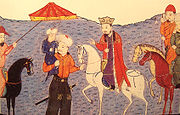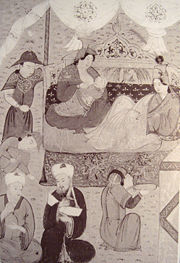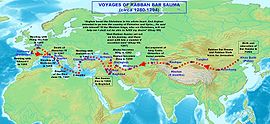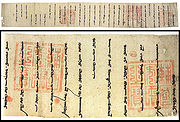
Arghun
Encyclopedia

- For the pre-Hulagu Mongol governor of Persia in the mid-1200s, see Arghun AqaArghun AqaArghun Agha, also Arghun Aqa or Arghun the Elder was a Mongol noble of the Oirat clan in the 13th century. He was a governor in the Mongol-controlled area of Persia from 1243 to 1255, before the Ilkhanate was created by Hulagu...
.
Arghun Khan aka Argon (Mongolian
Mongolian language
The Mongolian language is the official language of Mongolia and the best-known member of the Mongolic language family. The number of speakers across all its dialects may be 5.2 million, including the vast majority of the residents of Mongolia and many of the Mongolian residents of the Inner...
: Arghun Khaan; Mongolian Cyrillic
Mongolian Cyrillic alphabet
The Mongolian Cyrillic script is the writing system used for the Khalkha dialect of the Mongolian language as the standard dialect of the modern state of Mongolia. Cyrillic has not been adopted by the Khalkha in the Inner Mongolia region of China, who still use the Mongolian script.Mongolian...
: Аргун хаан) (c. 1258 – March 7, 1291) was the fourth ruler of the Mongol empire's
Mongol Empire
The Mongol Empire , initially named as Greater Mongol State was a great empire during the 13th and 14th centuries...
Ilkhanate
Ilkhanate
The Ilkhanate, also spelled Il-khanate , was a Mongol khanate established in Azerbaijan and Persia in the 13th century, considered a part of the Mongol Empire...
, from 1284 to 1291. He was the son of Abaqa Khan
Abaqa Khan
Abaqa Khan , also Abaga , or Abagha Khan, was the second Mongol ruler of the Persian Ilkhanate. The son of Hulagu Khan and Yesuncin Khatun, he reigned from 1265–1282 and was succeeded by his brother Tekuder Khan...
, and like his father, was a devout Buddhist (although pro-Christian). He was known for sending several embassies to Europe in an unsuccessful attempt to form a Franco-Mongol alliance
Franco-Mongol alliance
Franco-Mongol relations were established in the 13th century, as attempts were made towards forming a Franco-Mongol alliance between the Christian Crusaders and the Mongol Empire against various Muslim empires. Such an alliance would have seemed a logical choice: the Mongols were sympathetic to...
against the Muslims in the Holy Land
Holy Land
The Holy Land is a term which in Judaism refers to the Kingdom of Israel as defined in the Tanakh. For Jews, the Land's identifiction of being Holy is defined in Judaism by its differentiation from other lands by virtue of the practice of Judaism often possible only in the Land of Israel...
. It was also Arghun who requested a new bride from his great-uncle Kublai Khan
Kublai Khan
Kublai Khan , born Kublai and also known by the temple name Shizu , was the fifth Great Khan of the Mongol Empire from 1260 to 1294 and the founder of the Yuan Dynasty in China...
. The mission to escort the young Kökötchin across Asia to Arghun was reportedly taken by Marco Polo
Marco Polo
Marco Polo was a Venetian merchant traveler from the Venetian Republic whose travels are recorded in Il Milione, a book which did much to introduce Europeans to Central Asia and China. He learned about trading whilst his father and uncle, Niccolò and Maffeo, travelled through Asia and apparently...
. Arghun died before Kökötchin arrived, so she instead married Arghun's son, Ghazan.
Biography

Abaqa Khan
Abaqa Khan , also Abaga , or Abagha Khan, was the second Mongol ruler of the Persian Ilkhanate. The son of Hulagu Khan and Yesuncin Khatun, he reigned from 1265–1282 and was succeeded by his brother Tekuder Khan...
and his Christian princess wife, Haimash Khatun. Arghun himself had multiple wives, and his mother-in-law Bulughan Khatun raised Arghun's two sons Ghazan (whose birth mother was Qutlugh) and Öljeitü (whose birth mother was Uruk Khatun), both of whom later succeeded him and eventually converted to Islam
Islam
Islam . The most common are and . : Arabic pronunciation varies regionally. The first vowel ranges from ~~. The second vowel ranges from ~~~...
. Arghun had Öljeitü baptized as a Christian at birth, and gave him the name "Nicholas" after Pope Nicholas IV
Pope Nicholas IV
Pope Nicholas IV , born Girolamo Masci, was Pope from February 22, 1288 to April 4, 1292. A Franciscan friar, he had been legate to the Greeks under Pope Gregory X in 1272, succeeded Bonaventure as Minister General of his religious order in 1274, was made Cardinal Priest of Santa Prassede and...
. According to the Dominican
Dominican Order
The Order of Preachers , after the 15th century more commonly known as the Dominican Order or Dominicans, is a Catholic religious order founded by Saint Dominic and approved by Pope Honorius III on 22 December 1216 in France...
missionary Ricoldo of Montecroce
Ricoldo of Montecroce
Riccoldo da Monte di Croce or Ricoldo of Monte Croce , c.1243 - 1320, was an Italian Dominican monk, travel writer, missionary, and Christian apologist.-Life:...
, he was "a man given to the worst of villainy, but for all that a friend of the Christians".
One of the sisters of Arghun, Oljalh, was married to the Georgian prince Wakhtang III
Vakhtang III of Georgia
Vakhtang III , of the dynasty of Bagrationi, was the king of Georgia from 1302 to 1308. he ruled during the Mongol dominance of Georgia....
.
Arghun was a Buddhist, but as did most Turco-Mongols, he showed great tolerance for all faiths, even allowing Muslims to be judged under Koranic law. His minister of finance, Sa'ad ad dawla, was a Jew. Sa'ad was effective in restoring order to the Ilkhanate's government, in part by aggressively denouncing the abuses of the Mongol military leaders.
Conflicts
Arghun's reign was relatively peaceful, and there were few conflicts with his fellow Mongols. He did fight a brief campaign against the Chagatai KhanateChagatai Khanate
The Chagatai Khanate was a Turko-Mongol khanate that comprised the lands ruled by Chagatai Khan , second son of the Great Khan Genghis Khan, and his descendents and successors...
in Khorasan
Greater Khorasan
Greater Khorasan or Ancient Khorasan is a historical region of Greater Iran mentioned in sources from Sassanid and Islamic eras which "frequently" had a denotation wider than current three provinces of Khorasan in Iran...
. In 1289-1290, he had to deal with an upheaval of the Oirat
Oirats
Oirats are the westernmost group of the Mongols who unified several tribes origin whose ancestral home is in the Altai region of western Mongolia. Although the Oirats originated in the eastern parts of Central Asia, the most prominent group today is located in the Republic of Kalmykia, a federal...
emir Nauruz, who had to flee to Transoxonia.
In 1288 and 1290, he repelled invasion forces of the Golden Horde
Golden Horde
The Golden Horde was a Mongol and later Turkicized khanate that formed the north-western sector of the Mongol Empire...
under Tulabuga in the area of the Caucasus
Caucasus
The Caucasus, also Caucas or Caucasia , is a geopolitical region at the border of Europe and Asia, and situated between the Black and the Caspian sea...
twice.
During Arghun's reign, the Egyptian Mamluk
Mamluk
A Mamluk was a soldier of slave origin, who were predominantly Cumans/Kipchaks The "mamluk phenomenon", as David Ayalon dubbed the creation of the specific warrior...
s continuously reinforced their power in Syria, and the Mamluk Sultan Qalawun
Qalawun
Saif ad-Dīn Qalawun aṣ-Ṣāliḥī was the seventh Mamluk sultan of Egypt...
re-captured Crusader territories, some of which, such as Tripoli, had been vassal states of the Turco-Mongols. The Mamluks captured the northern fortress of Margat
Margat
Margat, also known as Marqab from the Arabic Qalaat al-Marqab is a castle near Baniyas, Syria, which was a Crusader fortress and one of the major strongholds of the Knights Hospitaller...
in 1285, Lattakia in 1287, and completed the Fall of Tripoli
Fall of Tripoli
The Fall of Tripoli was the capture and destruction of the Crusader state, the County of Tripoli , by the Muslim Mamluks...
in 1289.
Relations with Christian powers
Arghun was one of a long line of Genghis-Khanite rulers who endeavoured to established a Franco-Mongol allianceFranco-Mongol alliance
Franco-Mongol relations were established in the 13th century, as attempts were made towards forming a Franco-Mongol alliance between the Christian Crusaders and the Mongol Empire against various Muslim empires. Such an alliance would have seemed a logical choice: the Mongols were sympathetic to...
with the Europeans, against their common enemies the Egyptian Mamluks. Arghun even promised that if Jerusalem were conquered, he would have himself baptised. But by the late 13th century, Western Europe was no longer as interested in the waning crusades, and Arghun's missions were ultimately fruitless.
First mission to the Pope
In 1285, Arghun sent an embassy and a letter to Pope Honorius IV, a Latin translation of which is preserved in the VaticanRoman Curia
The Roman Curia is the administrative apparatus of the Holy See and the central governing body of the entire Catholic Church, together with the Pope...
. Arghun's letter mentioned the links that Arghun's family had to Christianity, and proposed a combined military conquest of Muslim lands:
Second mission, to Kings Philip and Edward

Rabban Bar Sauma
Rabban Bar Sauma , also known as Rabban Ṣawma or Rabban Çauma, , was a Turkic/Mongol monk turned diplomat of the Nestorian Christian faith. He is known for embarking on a pilgrimage from Mongol-controlled China to Jerusalem with one of his students, Rabban Markos...
, with the objective of contracting a military alliance to fight the Muslims in the Middle East, and take the city of Jerusalem. The responses were positive but vague. Sauma returned in 1288 with positive letters from Pope Nicholas IV
Nicholas IV
Nicholas IV can refer to:* Pope Nicholas IV * Patriarch Nicholas IV of Constantinople * Patriarch Nicholas IV of Alexandria...
, Edward I of England
Edward I of England
Edward I , also known as Edward Longshanks and the Hammer of the Scots, was King of England from 1272 to 1307. The first son of Henry III, Edward was involved early in the political intrigues of his father's reign, which included an outright rebellion by the English barons...
, and Philip IV the Fair of France.
Third mission

Buscarello was also bearing a memorandum explaining that the Mongol ruler would prepare all necessary supplies for the Crusaders, as well as 30,000 horses. Buscarel then went to England to bring Arghun's message to King Edward I
Edward I of England
Edward I , also known as Edward Longshanks and the Hammer of the Scots, was King of England from 1272 to 1307. The first son of Henry III, Edward was involved early in the political intrigues of his father's reign, which included an outright rebellion by the English barons...
. He arrived in London January 5, 1290. Edward, whose answer has been preserved, answered enthusiastically to the project but remained evasive about its actual implementation, for which he deferred to the Pope.
Assembly of a raiding naval force
In 1290, Arghun launched a shipbuilding program in Baghdad, with the intent of having war galleys which would harass the Mamluk commerce in the Red SeaRed Sea
The Red Sea is a seawater inlet of the Indian Ocean, lying between Africa and Asia. The connection to the ocean is in the south through the Bab el Mandeb strait and the Gulf of Aden. In the north, there is the Sinai Peninsula, the Gulf of Aqaba, and the Gulf of Suez...
. The Genoese
Republic of Genoa
The Most Serene Republic of Genoa |Ligurian]]: Repúbrica de Zêna) was an independent state from 1005 to 1797 in Liguria on the northwestern Italian coast, as well as Corsica from 1347 to 1768, and numerous other territories throughout the Mediterranean....
sent a contingent of 800 carpenters and sailors, to help with the shipbuilding. A force of arbaletiers was also sent, but the enterprise apparently foundered when the Genoese government ultimately disowned the project, and an internal fight erupted at the Persian Gulf
Persian Gulf
The Persian Gulf, in Southwest Asia, is an extension of the Indian Ocean located between Iran and the Arabian Peninsula.The Persian Gulf was the focus of the 1980–1988 Iran-Iraq War, in which each side attacked the other's oil tankers...
port of Basra
Basra
Basra is the capital of Basra Governorate, in southern Iraq near Kuwait and Iran. It had an estimated population of two million as of 2009...
among the Genoese (between the Guelfe and the Gibelin families).
Fourth mission
Arghun sent a fourth mission to European courts in 1290, led by Andrew Zagan (or Chagan), who was accompanied by Buscarel of Gisolfe and a Christian named Sahadin.In 1291, Pope Nicolas IV proclaimed a new Crusade and negotiated agreements with Arghun, Hetoum II of Armenia, the Jacobites
Jacobite Syrian Christian Church
The Jacobite Syrian Christian Church is part of the Syriac Orthodox Church, located in Kerala, India. It recognizes the Syriac Orthodox Patriarch of Antioch, currently Ignatius Zakka I Iwas, as its supreme head. It functions as a largely autonomous archdiocese within the church, under the authority...
, the Ethiopians and the Georgians
Georgians
The Georgians are an ethnic group that have originated in Georgia, where they constitute a majority of the population. Large Georgian communities are also present throughout Russia, European Union, United States, and South America....
. On January 5, 1291, Nicolas addressed a vibrant prayer to all the Christians to save the Holy Land, and predicators started to rally Christians to follow Edward I in a Crusade.
However, the efforts were too little and too late. On May 18, 1291, Saint-Jean-d'Acre was conquered by the Mamluks in the Siege of Acre
Siege of Acre (1291)
The Siege of Acre took place in 1291 and resulted in the loss of the Crusader-controlled city of Acre to the Muslims. It is considered one of the most important battles of the time period. Although the crusading movement continued for several more centuries, the capture of the city marked the end...
.
In August 1291, Pope Nicolas wrote a letter to Arghun informing him of the plans of Edward I to go on a Crusade to recapture the Holy Land, stating that the Crusade could only be successful with the help of the "powerful arm" of the Mongols. Nicolas repeated an oft-told theme of the Crusader communications to the Mongols, asking Arghun to receive baptism and to march against the Mamluks. However Arghun himself had died on March 10, 1291, and Pope Nicholas IV would die in March 1292, putting an end to their attempts at combined action.
Edward I sent an ambassador to Arghun's successor Gaikhatu in 1292 in the person of Geoffrey de Langley, but extensive contacts would only resume under Arghun's son Ghazan.
According to the 20th century historian Runciman, "Had the Mongol alliance been achieved and honestly implemented by the West, the existence of Outremer
Outremer
Outremer, French for "overseas", was a general name given to the Crusader states established after the First Crusade: the County of Edessa, the Principality of Antioch, the County of Tripoli and especially the Kingdom of Jerusalem...
would almost certainly have been prolonged. The Mameluks would have been crippled if not destroyed; and the Ilkhanate of Persia would have survived as a power friendly to the Christians and the West"
Death
Arghun died on March 7, 1291, and was succeeded by his brother GaykhatuGaykhatu
Gaykhatu was the fifth Ilkhanate ruler in Iran. He reigned from 1291 to 1295. During his reign, Gaykhatu was a noted dissolute who was addicted to wine, women, and sodomy...
.
The 13th century saw such a vogue of Mongol things in the West that many new-born children in Italy were named after Genghis-Khanite rulers, including Arghun: names such as Can Grande ("Great Khan"), Alaone (Hulagu), Argone (Arghun) or Cassano (Ghazan) are recorded with a high frequency.
Marco Polo
Arghun was the stated reason why Marco PoloMarco Polo
Marco Polo was a Venetian merchant traveler from the Venetian Republic whose travels are recorded in Il Milione, a book which did much to introduce Europeans to Central Asia and China. He learned about trading whilst his father and uncle, Niccolò and Maffeo, travelled through Asia and apparently...
was able to return to Venice
Venice
Venice is a city in northern Italy which is renowned for the beauty of its setting, its architecture and its artworks. It is the capital of the Veneto region...
after 23 years of absence. Arghun, having lost his favourite wife Bolgana, asked his granduncle and ally Kublai Khan
Kublai Khan
Kublai Khan , born Kublai and also known by the temple name Shizu , was the fifth Great Khan of the Mongol Empire from 1260 to 1294 and the founder of the Yuan Dynasty in China...
to send him one of Bolgana's relatives as a new bride. The choice fell to the 17-year-old Kökötchin ("Blue, or Celestial, Dame"). Marco Polo was given the task of accompanying the princess through land and sea routes, navigating on a Mongolian ship through the Indian Ocean
Indian Ocean
The Indian Ocean is the third largest of the world's oceanic divisions, covering approximately 20% of the water on the Earth's surface. It is bounded on the north by the Indian Subcontinent and Arabian Peninsula ; on the west by eastern Africa; on the east by Indochina, the Sunda Islands, and...
to Persia. The journey took two years and Arghun died in the meantime, so Kökötchin instead married Arghun's son Ghazan.

